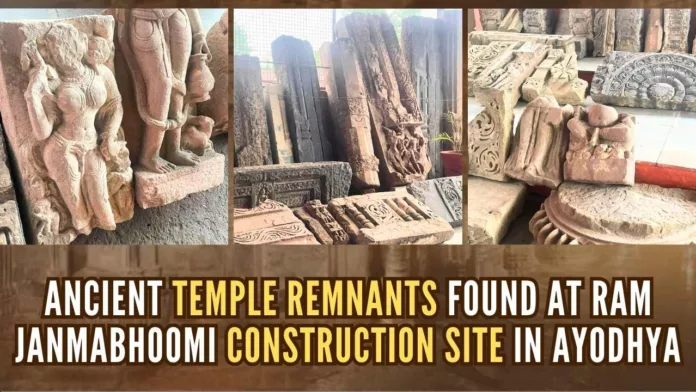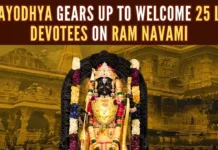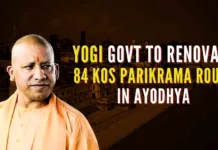
Statues, pillars, stones… Remains of ancient temple found during excavation at Ram Janmabhoomi in Ayodhya
The lies of uncouth Left historians are again exposed. Champat Rai, the General Secretary of Shri Ram Janmabhoomi Teerth Kshetra said the excavations at Ram Janmabhoomi construction site in Ayodhya uncovered remnants of ancient temple. Rai shared the photos of these remnants on September 12 and September 13 through a post in X. “Remains of an ancient temple found during excavation at Shri Ram Janmabhoomi. It includes many statues and pillars,” said Rai sharing the photos of remnants of the ancient temple at Ram Janmabhoomi.
On September 12, Champat Rai shared photos of remnants of the ancient temple from the temple construction site.
श्री रामजन्मभूमि पर खुदाई में मिले प्राचीन मंदिर के अवशेष। इसमें अनेकों मूर्तियाँ और स्तंभ शामिल हैं। pic.twitter.com/eCBPOtqE1W
— Champat Rai (@ChampatRaiVHP) September 12, 2023
The next day September 13, Champat Rai shared more photos of the ancient temple’s remnants in Ayodhya.
Sharing some more pictures of remains of the ancient temple that have been discovered at Shri Ram Janmabhoomi site in Ayodhya. pic.twitter.com/32LcpRKTUd
— Champat Rai (@ChampatRaiVHP) September 13, 2023
Earlier, three years ago in May 2020 also Champat Rai shared the photos of ancient temple remnants found from the Ram Mandir construction site at Ayodhya.[1]
The Archaeological Survey of India (ASI) Report to the Allahabad High Court in 2003 after excavation clearly says that Masjid was built after destroying a temple. The very last page – Page No: 272 – clearly sums up that the ASI team found the remains of a temple in their High Court-monitored excavation in 2003. The last paragraph of the ASI Report clearly says that there was a “massive temple” structure below the Babri Masjid which was demolished in 1992 by Kar Sevaks of Sangh Parivar. The report says the temple structures date back to the tenth century. The Report details the finding of more than 50 pillars with Hindu scriptures, Hindu religious divine couples, lotus motifs, etc. In its last line, the ASI Report categorically states that “fifty pillar bases in an association of the huge structure, are indicative of remains which are distinctive features found associated with the temples of north India.” Noted archeologist K K Muhammed wrote many articles in this regard showing the presence of ancient temple remnants at Ayodhya.
The very last paragraph of the ASI report is reproduced below:
“The Hon’ble High Court, in order to get sufficient archaeological evidence on the issue involved “whether there was any temple/structure which was demolished and a mosque was constructed on the disputed site” as stated on page 1 and further on p.5 of their order dated 5 march 2003, had given directions to the Archaeological Survey of India to excavate at the disputed site where the GPR Survey has suggested evidence of anomalies which could be structure, pillars, foundation walls, slab flooring etc, which could be confirmed by excavation. Now, viewing in totality and taking into account the archaeological evidence of a massive structure just below the disputed structure and evidence of continuity in structural phases from the tenth century onwards up to the construction of the disputed structure along with the yield of stone and decorated bricks as well as mutilated sculpture of divine couple and carved architectural members including foliage patterns, amalaka, kapotapali doorjamb with semi-circular pilaster, broken octagonal shaft of black schist pillar, lotus motif, circular shrine having pranala (water chute) in the north, fifty pillar bases in association of the huge structure, are indicative of remains which are distinctive features found associated with the temples of north India.,’ said the last paragraph of the Page 272 of the ASI Report which clearly stated that Babri Masjid was constructed by destroying a Hindu Temple.[2]
Reference:
[1] Uncouth Left historians exposed – old temple remnants found in Ayodhya. Now proved beyond doubt Masjid was built by destroying Ram Mandir – May 21, 2020, PGurus.com
[2] The ASI report clearly told Court that Babri Masjid was built by destroying a massive Temple in Ayodhya – Nov 12, 2019, PGurus.com
For all the latest updates, download PGurus App.
- Supreme Court rejects plea to tally all VVPAT slips with EVM votes; says ‘no going back to paper ballot’ - April 26, 2024
- US report citing human rights violations is deeply biased: India - April 25, 2024
- Kotak Mahindra Bank shares tank 13%. Market Cap erodes by Rs.37,721 cr post-RBI action - April 25, 2024










